S.C. Skillman's Blog, page 62
January 13, 2014
Why I Believe Mankind Can Never ‘Own’ the Moon
Nobody Owns the Moon.

a romantic image of the moon – a perpetual source of inspiration for artists and poets
On Friday morning January 10th 2014 I heard Mishal Husain interview Ian Crawford and Nicola Triscott on this topic on the BBC Radio 4 Today programme.
Nicola Triscott has mounted an exhibition on London’s South Bank called Republic of the Moon. She has transformed The Bargehouse at Oxo Tower Wharf into ’an artist’s lunar embassy on earth’.
During the interview we heard a quote from Article 1 of the 1967 Outer Space Treaty: “the moon is the province of all mankind”. Apparently Article 2 prohibits nation states from appropriating the moon.
But now there is some concern that that treaty should be updated, and private corporations should also be added to the provision.
In 1967 it was never thought that any private corporation would be in the position of being able to exploit the resources on the moon.
When in the history of the human race have such words on treaties and constitutions and charters of human rights ever been respected in reality?
Colonial invaders have always operated on the principle of Finders Keepers. First here exploits it all.
Such was the case with Captain Cook, Don Cortez and many such.
An exhibit on The History of Human Conflict at the Firepower Museum, Royal Arsenal Thames Riverside, Woolwich, (a brilliant museum which I recommend to all), tells us that human conflict began when men turned from hunter gatherers to farmers. Mankind began to fight over the limited resources of land suitable for cultivation. The source of all human conflict is: limited resources.
God grant there are no resources on the moon that can ever be of any economic value to mankind.
For man is greedy. I generally do not have an optimistic view of human nature. And neither does JRR Tolkien. His own view was expressed through the words of the Lady Galadriel in The Lord of the Rings: the race of men…. above all else desire power… the hearts of men are easily corrupted and the Ring of Power has a will of its own.
For exploitable resources, read the Ring of Power. If there are valuable resources on the moon, I believe that mankind WILL fight over them, and private corporations and nation states WILL exploit them to gain and increase their power.
Let the moon continue to be the sole province of poets and mystics; of those who gave us glimpses of eternity, of creative writers, and those who dream, and those who deal in mystery and imagination. And let the only lunar resources we draw upon be those of inspiration.
Filed under: 1960s, Authors I love, Books, creative writing, dreams and dreaming, faith, history, inspiration, life, literature, love, media, movies, musings, news, places of inspiration, SC Skillman, SC Skillman Author, spirituality, thoughts Tagged: BBC Radio 4, belong to mankind, creative writers, dreams, exploit resources, Galadriel, glimpses of eternity, human conflict, I believe that, imagination, JRR Tolkien, limited resources, mystical experiences, nobody owns the moon, Outer Space Treaty, The Lord of the Rings, the moon, Today Programme


January 9, 2014
Kitten Welcoming in 2014
Here is Molly, who has now learned to lie on the rug in front of the fire, instead of trying to climb onto the fire and play with the flames:

Molly in Jan 2014 (photo credit Abigail Robinson)
Filed under: SC Skillman Tagged: cat in front of fire


January 1, 2014
A Fresh Insight Into One of History’s Villains, With the Help of Shakespeare and David Tennant
The highlight of our Christmas was a visit to the Barbican Theatre, London, on Saturday 21 December 2013, to see David Tennant performing in the role of Shakespeare’s Richard II.
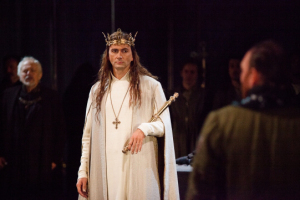
David Tennant as Richard II (photo credit Kwame Lestrade)
Richard II is one of English history’s villains.
So who better to play him on stage and change our view of him than one of our contemporary heroes, the charismatic David Tennant?
But Richard II is also one of those kings who is a mystery to many of us; what we do know may be gleaned from primary school history, or a visit to Westminster Abbey.
There the main thing we learn about him is that he was murdered on the orders of his successor, Henry IV, and his body was initially buried somewhere else, but eventually Henry IV felt so guilty he moved the former king to the grand tomb he’d originally had built for himself in Westminster Abbey – which is where we may contemplate him today.
Richard II: An Unbalanced King, we are told in the brilliant comic classic book 1066 And All That, was only a boy at his accession: one day, however, suspecting that he was now twenty-one, he asked his uncle, and, on learning that he was, mounted the throne himself and tried first being a Good King and then being a Bad King, without enjoying either very much.
David Tennant’s Richard II showed us a petulant, whining, rather effete, figure in what my two teenagers could only describe as long hair and a long white nightie (and of course a crown on his head).
We were there because my two teenagers love David Tennant for being Doctor Who.
Yet how he opened up my view of this bad king.
All the raw vulnerability of the character was there, and I ended up feeling much more about Richard than that he was simply a baddie basking in undeserved glory in a tomb in Westminster Abbey.
Instead he was a real live fragile human being, with his moral weakness and disastrous decisions, different on the inside from the outside, as we all are.
This is what I wrote about Richard II in an ezine article in 2011:
For example, take a walk round Westminster Abbey, as I did the other day – here, in this major spiritual hub and London tourist attraction you’ll pass the shrine of St Edward the Confessor, and find clustered around him many monuments and tombs. The official tourist guide says these speak both of human dignity and achievement. But do they? Among them we find both the goodies and the baddies. Some are noble but others got there by ruthlessly exploiting everyone and everything in their lust for power.
Of course, after contemplating Richard II, who was so awful he was murdered by his successor, but still eventually ended up in the grand tomb he’d built for himself in the abbey, we can then move on to Poets Corner which shows us a much better aspect of human nature, celebrating creativity and genius to uplift and inspire us.
But now Shakespeare and David Tennant between them have deepened my view of Richard – as all great creatives must do with the characters they portray.
Filed under: book reviews, Books, British, history, inspiration, interpersonal relationships, life, London, media, musings, people of inspiration, psychology, SC Skillman, SC Skillman Author, stage drama, thoughts, TV programmes, UK, Writing Tagged: 1066 And All That, Barbican Theatre, charismatic, David Tennant, Doctor Who, English history, fresh insight, great creatives, heroes, London, mystery, Richard II, SC Skillman author, Shakespeare, villains, Westminster Abbey


2013 in review
The WordPress.com stats helper monkeys prepared a 2013 annual report for this blog.
Here’s an excerpt:
A New York City subway train holds 1,200 people. This blog was viewed about 7,700 times in 2013. If it were a NYC subway train, it would take about 6 trips to carry that many people.
Click here to see the complete report.
Filed under: British psychological suspense writer, creative writing, empowerment, inspiration, life, musings, SC Skillman, SC Skillman Author, Writing Tagged: creative writers, creative writing, dare to believe, inspiration, SC Skillman, SC Skillman author, SCSkillman blog stats 2013


December 18, 2013
Live Christmas Present Under the Tree: One Kitten
Here is Molly who believes she makes as good a Christmas present as any other you might find under the tree.

Molly under the Christmas Tree 17 Dec 2013 (photo credit Abigail Robinson)
Filed under: life, nature, wildlife Tagged: cat, Christmas present, Christmas tree, kitten, live, SC Skillman


December 9, 2013
Standing Ovations and Encores for Songlines Community Choir in Leamington Spa
On Saturday night 7 December 2013 our local community choir, Songlines, conducted by Bruce Knight, gave a concert at St Mary’s Church, in Leamington Spa, to raise money for Water Aid.
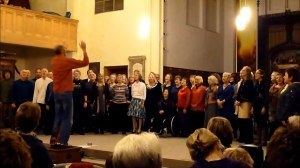
Bruce Knight conducting Songlines Community Choir in a performance of Nkosi Sikelelik ‘lAfrika in St Mary’s Church Leamington Spa on Saturday 7 December 2013
It was a night where we saw and felt the power of music to bring joy and to uplift.
A standing ovation and calls for an encore confirmed this.
Our programme encompassed community choir arrangements of the moving Zulu song Egalile, full of exhuberant synchronized movements, including our well-rehearsed African shuffle; Let the River Run by Carly Simon, Sunday Morning by Reed & Cale, arr.Knight; the Beatles’ song Nowhere Man; Wake Up by Nick Prater arr. Ali Orbaum, and the Samoan song Fa’afetai i le Atua arr. Tony Backhouse.
A smaller group called Extra-stronglines also sang the gorgeous harmonies of the Beatles’ song Because.
A highlight was a performance of the South African National anthem Nkosi Sikeleli’l Afrika in tribute to the recent passing of Nelson Mandela.
And at the end, we walked off the stage, singing Love is like a river, let it flow, let it flow, let it flow.
I’ve sung in choirs since I was 9 years old, when I joined a girls choir in my hometown, Orpington in Kent: The Orpington Junior Singers, conducted by Sheila Mossman. Some of the former singers in this choir now belong to The Newstead Singers in Orpington, and their conductor, Lesley Cooper, is one of the girls I remember from the days I sang with them.
Over the course of my life I’ve sung in numerous other choirs, covering many major choral works.
It’s an enriching experience to sing in Bach’s St Matthew Passion and Mass in B Minor, Elgar’s Dream of Gerontius, and Beethoven’s Missa Solemnis.
But the experience of singing in a community choir is quite different. It is another joy, of a different order. We learn the music by ear, without sheet music, and Bruce ensures each rehearsal begins with a fun warm-up session. Our singing often involves movement too, borrowed from Bruce’s circle dancing class which he runs on another day of the week.
Gareth Malone eat your heart out!
Music has charms to soothe a savage breast, wrote William Congreve, and how right he was. Music has tremendous power to transform us emotionally and psychologically, to lift us out of negative moods and sad thoughts, and it is the most spiritual of the arts.
Long may we celebrate the gift of music in our lives.
Filed under: inspiration, life, love, music, musings, people of inspiration, spirituality, thoughts Tagged: arts, choirs, circle, community choir, encores, Gareth Malone, gift of music, inspirational, joy, love, music, Nelson Mandela, people of inspiration, power, power to transform, singing, South African National anthem, spiritual, standing ovations, uplift, Water Aid


December 2, 2013
Lovely Lake District in Autumn 2013
We spent a few days in England’s lovely Lake District during the recent autumn half term.

Ashness Bridge, near Derwentwater (photo credit Abigail Robinson)
The Lake District is special to me, not only because of its association with numerous famous writers, with Beatrix Potter, John Ruskin, William Wordsworth; but also because of memories from childhood holidays there, and the fact that I regularly visited it during the time I spent as an undergraduate at Lancaster University (approximately 40 minutes drive from Windermere).
As a member of the university hiking club, I became familiar with the Old Man of Coniston and Scafell Pike and I soon learned that hiking didn’t mean gentle rambling, it meant something very akin to mountain-climbing except without the ropes and crampons, as we scrambled up and slid down steep slopes of scree!

cruise on Lake Windermere (photo credit Abigail Robinson)
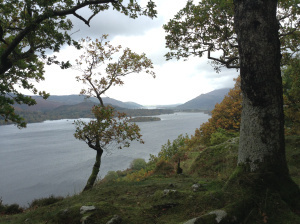
Surprise View, Derwentwater (photo credit Abigail Robinson)
Bowness-on-Windermere is distinctive for me, as I would go there with my parents when they came to visit me for the weekend. For me, it was a translation from the world of student accommodation to the Old England Hotel. I returned there on later occasions with friends, for afternoon tea on the terrace, overlooking Lake Windermere. The Old England Hotel has held a special place in my memory ever since.
It is said that the Lake District has the highest rainfall in England. Those who go there must take mist, rain, muted colours, a moist atmosphere, brooding clouds, along with everything else the Lake District has to offer; and be prepared to carry on regardless, wearing waterproofs. If you experience the lakes and mountains in bright sunshine, count yourself blessed!
The Lake District is an inspirational place that speaks directly to the spirit.
Here are some more images from our recent visit:

Derwentwater from Keswick (photo credit Abigail Robinson)
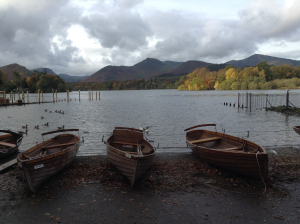
Boats beside Derwentwater (photo credit Abigail Robinson)
Filed under: Authors I love, British, British landscape, creative writing, dreams and dreaming, English countryside, inspiration, life, literature, love, musings, nature, places I love, places of inspiration, SC Skillman, SC Skillman Author, travel, UK, Writing Tagged: autumn, blessed, Bowness-on-Windermere, Derwentwater, England, imagination, inspirational, Lake District, lakes and mountains, memory, Old England Hotel, special, special place, spirit, writers


November 26, 2013
New Official Trailer for Mystical Circles
Watch the new official trailer for Mystical Circles on my YouTube channel.

Craig’s Farmhouse in MYSTICAL CIRCLES (photo credit Abigail Robinson)
Directed, produced, filmed and scripted by my daughter Abigail Robinson, who is a Creative Media Production student, it’s been six months in the making, and Abigail has done brilliantly.
For those of you living in England, in the deep chill of November, watch the idyllic shots of the Cotswolds in high summer, and may your spirits be lifted, as mine are.
Please share in the comments as I’d love to know your thoughts on the trailer!
Filed under: Books, British, British landscape, British psychological suspense writer, creative writing, English countryside, inspiration, life, literature, media, Mystical Circles, nature, places I love, places of inspiration, psychological suspense fiction, SC Skillman, SC Skillman Author, spirituality, thoughts, Writing Tagged: Cotswolds, creative, high summer, idyllic, love, mystical circles, new, official book trailer, SC Skillman author, spirits


November 25, 2013
Why Do So Many of Us Love Doctor Who?
So many children’s bedrooms up and down the UK and around the world must look similar to this one, in our home.

Doctor Who display in teen bedroom (photo credit Abigail Robinson)
In the recent celebrations of the 50th anniversary of the BBC drama series Doctor Who, the question has been posed: why do you think Doctor Who is so popular?
Since everyone in our house loves the Doctor, I’ve asked myself this question. And I concluded that we love the Doctor because:
* As a fictional character, he is a perfect combination of science and religion. He has the Christlike qualities of power, knowledge and goodness; combined with the vast possibilities of science. He plays into our archetypal longings for balance and justice in the universe, plus our thirst for knowledge and our fascination with the potential of science and our quest for empowerment.
* he has power over time. Time, death and the ageing process are among those things we cannot control, though we dream of doing so.
* he engages us on a spiritual level. He represents the perpetual battle between good and evil.
* the character of the Doctor, with all this power, knowledge and goodness, contains both playfulness and gravity. We respond at a deep level to paradox. Every one of the eleven actors who has played the Doctor has at some level combined the weight of ultimate responsibility and moral integrity with a quirky, mercurial quality. And the twelfth Doctor seems set fair to carry this same quality.
* we are always learning new things about the Doctor. He always retains his mystery.
* the Doctor is essentially lonely and poignant. He loves, and he evokes love. Yet he can never become emotionally attached to any one human – not without tragic repercussions or complex tampering with the space time continuum.
* he regenerates, just like nature, just like the Green Man, a symbol of rebirth, found in many cultures from many ages around the world.
The Doctor is all these things and more.

Doctor Who rules in teen bedroom (photo credit Abigail Robinson)
And we love him not only because of all this, but because of the genius of all those involved: the executives, actors, writers, directors, producers, monster-creators, technical people, visual and special effects people and composers and musicians. They will have overcome everything that human weakness can throw at them, during the fifty years of the programme’s life, as we saw only too well from the Adventure in Space and Time episode about BBC executive Sydney Newman, actor William Hartnell, producer Verity Lambert, and director Waris Hussein.
It all seems summed up in David Tennant’s cry: “I don’t want to go.”
Yet the archetypal power of this fictional character, his relationships, his story represents for many our dream of transcending those limitations and that frailty.
Filed under: 1960s, British, culture, dreams and dreaming, empowerment, faith, inspiration, life, love, media, musings, people of inspiration, psychology, religion, SC Skillman Author, spirituality, thoughts, TV programmes, UK, Writing Tagged: 50th anniversary, ageing process, archetypes, BBC drama, Christians, Christlike, control, death, Doctor Who, dreams, empowerment, goodness, Green Man, inspiration, knowledge, life, love, mystery, paradox, power, science, spiritual, time, Time Lord, universe knowledge


November 20, 2013
Mystical Circles Kindle Countdown Deal; A Passionate Spirit Follows Fast!
Mystical Circles is on Kindle Countdown Deal for seven days.
On 21 November the price drops to 99p.
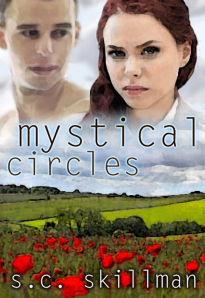
Mystical Circles cover image
Two days later it steps up to £1.99.
And on 25 November it returns to its original list price £3.37.
Go over to the Kindle Store to get it when the price is right!
Meanwhile my new novel A Passionate Spirit nears completion, as I revise the manuscript for a commissioning editor.
A Passionate Spirit is a psycho-spiritual suspense novel with a dramatic storyline.
It features a fictional character my editor described as a wonderfully creepy and intimidating baddie.
Other hot news is I will be uploading a new trailer video for Mystical Circles on my YouTube channel within the next week.
To whet your appetite here are a few preview shots from the trailer.

Craig’s Farmhouse in MYSTICAL CIRCLES (photo credit Abigail Robinson)

Lamp and flowers in Craig’s farmhouse in Mystical Circles (photo credit Abigail Robinson)
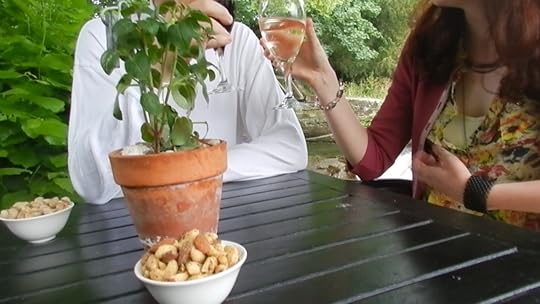
actors playing Zoe & Craig in Mystical Circles (photo credit: Abigail Robinson)
Filed under: SC Skillman






